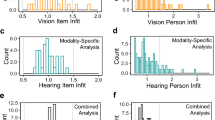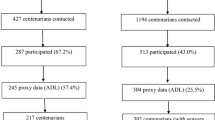Abstract
Purpose
Research focusing on the consequences of sensory impairments for the everyday competence of the oldest-old is emerging. The two main goals of this study were to document the prevalence of self-reported vision, hearing, and dual sensory impairment and to explore associations of these impairments with functional disability in near-centenarians and centenarians.
Methods
Centenarians and near-centenarians (N = 119; average age = 99) were recruited, with about 80 % living in the community. In-person interviews included self-ratings of vision and hearing impairment and functional disability conceptualized as having difficulties performing personal and instrumental activities of daily livings (PADLs and IADLs).
Results
Based on self-report ratings, 17 % of participants were classified as having a visual impairment only, 18 % as having a hearing impairment only, and 38 % with both a visual and hearing impairment (dual sensory impairment). Regression analyses demonstrated that having a vision impairment only and being dual sensory impaired were the strongest predictors of functional disability. They were associated with higher levels of functional disability over and above higher levels of depressive symptomatology, interference of health with desired activities, and living in a nursing home.
Conclusions
Sensory impairments—especially dual sensory impairment—are prevalent in the oldest-old. Having dual sensory impairment or a single visual impairment among other factors are strongly associated with less-optimal everyday functioning in the oldest-old.

Similar content being viewed by others
References
Crews, J. E., & Campbell, V. A. (2001). Health conditions, activity limitations and participation restrictions among older people with visual impairments. Journal of Visual Impairment and Blindness, 95, 453–467.
Horowitz, A., Brennan, M., & Reinhardt, J. P. (2005). Prevalence and risk factors for self-reported visual impairment among middle-aged and older adults. Research on Aging, 27, 307–326.
Ryskulova, A., et al. (2008). Self-Reported age-related eye diseases and visual impairment in the United States: Results of the 2002 National Health Interview Survey. American Journal of Public Health, 98, 454–461.
Agrawal, Y., Platz, E. A., & Niparko, J. K. (2008). Prevalence of hearing loss and differences by demographic characteristics among US adults: Data from the National Health and Nutrition Examination Survey, 1999–2004. Archives of Internal Medicine, 168(14), 1522.
Gopinath, B., Rochtchina, E., Wang, J. J., Schneider, J., Leeder, S. R., & Mitchell, P. (2009). Prevalence of age-related hearing loss in older adults: Blue Mountains Study. Archives of Internal Medicine, 169(4), 415.
Brennan, M., Horowitz, A., & Su, Y. P. (2005). Dual sensory loss and its impact on everyday competence. The Gerontologist, 45(3), 337–346.
Caban, A. J., Lee, D. J., Gómez-Marín, O., Lam, B. L., & Zheng, D. D. (2005). Prevalence of concurrent hearing and visual impairment in US adults: The National Health Interview Survey, 1997–2002. Journal Information, 95(11), 1940.
Wahl, H. W., Heyl, V., Drapaniotis, P. M., Hörmann, K., Jonas, J. B., Plinkert, P. K., & Rohrschneider, K. (2013). Severe vision and hearing impairment and successful aging: A multidimensional view. The Gerontologist, 53(6), 950–962.
Cacciatore, F., Napoli, C., Abete, P., Marciano, E., Triassi, M., & Rengo, F. (1999). Quality of life determinants and hearing function in an elderly population: Osservatorio Geriatrico Campano Study Group. Gerontology, 45(6), 323–328.
Carabellese, C., Appollonio, I., Rozzini, R., Bianchetti, A., Frisoni, G. B., Frattola, L., et al. (1993). Sensory impairment and quality of life in a community elderly population. Journal of the American Geriatrics Society, 41(4), 401.
Kramer, S. E., Kapteyn, T. S., Kuik, D. J., & Deeg, D. J. (2002). The association of hearing impairment and chronic diseases with psychosocial health status in older age. Journal of Aging and Health, 14(1), 122–137.
Dalton, D. S., Cruickshanks, K. J., Klein, B. E., Klein, R., Wiley, T. L., & Nondahl, D. M. (2003). The impact of hearing loss on quality of life in older adults. The Gerontologist, 43(5), 661–668.
Bookwala, J., & Lawson, B. (2011). Poor vision, functioning, and depressive symptoms: A test of the activity restriction model. The Gerontologist, 51, 798–808.
Burmedi, D., Becker, S., Heyl, V., Wahl, H. W., & Himmelsbach, I. (2002). Behavioral consequences of age-related low vision: A narrative review. Visual Impairment Research, 4, 15–45.
Horowitz, A. (2004). The prevalence and consequences of vision impairment in later life. Topics in Geriatric Rehabilitation, 20(3), 185–195.
Kempen, G. I., Ballemans, J., Ranchor, A. V., van Rens, G. H., & Zijlstra, G. R. (2012). The impact of low vision on activities of daily living, symptoms of depression, feelings of anxiety and social support in community-living older adults seeking vision rehabilitation services. Quality of Life Research, 21, 1405–1411.
Casten, R. J., Rovner, B. W., & Tasman, W. (2004). Age-related macular degeneration and depression: A review of recent research. Current Opinions Ophthalmology, 15, 181–183.
Horowitz, A., & Reinhardt, J. P. (2000). Depression among low vision elders. In C. Stuen, A. Arditi, A. Horowitz, M. A. Lang, B. Rosenthal, & K. Seidman (Eds.), Vision rehabilitation. Assessment, intervention and outcomes (pp. 655–658). Lisse, The Netherlands: Swets & Zeitlinger Publishers.
Mitchell, J., & Bradley, C. (2006). Quality of life in age-related macular degeneration: A review of the literature. Health and Quality of Life Outcomes, 4, 97.
Wang, S. Y., Singh, K., & Lin, S. C. (2012). Prevalence and predictors of depression among participants with glaucoma in a nationally representative population sample. American Journal of Ophthalmology, 154(3), 436–444.
Burmedi, D., Becker, S., Heyl, V., Wahl, H.-W., & Himmelsbach, I. (2002). Emotional and social consequences of age-related low vision: A narrative review. Visual Impairment Research, 4, 47–71.
Patino, C. M., McKean-Cowdin, R., Azen, S. P., Allison, J. C., Choudhury, F., Varma, R., et al. (2010). Central and peripheral visual impairment and the risk of falls and falls with injury. Ophthalmology, 117, 199–206.
Cummings, S. R., Nevitt, M. C., Browner, W. S., Stone, K., Fox, K. M., Ensrud, K. E., et al. (1995). Risk factors for hip fracture in white women. Study of Osteoporotic Fractures Research Group. New England Journal of Medicine, 23, 767–773.
Nguyen, H. T., Black, S. A., Ray, L. A., Espino, D. V., & Markides, K. S. (2002). Predictors of decline in MMSE scores among older Mexican Americans. The Journals of Gerontology Series A: Biological Sciences and Medical Sciences, 57(3), M181–M185.
Lee, D. J., Gómez-Marín, O., Lam, B. L., & Zheng, D. D. (2002). Visual acuity impairment and mortality in US adults. Archives of Ophthalmology, 120, 1544–1550.
Capella-McDonnall, M. E. (2005). The effects of single and dual sensory loss on symptoms of depression in the elderly. International Journal of Geriatric Psychiatry, 20(9), 855–861.
Keller, B. K., Morton, J. L., Thomas, V. S., & Potter, J. F. (1999). The effect of visual and hearing impairments on functional status. Journal of the American Geriatrics Society, 47(11), 1319.
Reuben, D. B., Mui, S., Damesyn, M., Moore, A. A., & Greendale, G. A. (1999). The prognostic value of sensory impairment in older persons. Journal of the American Geriatrics Society, 47(8), 930.
Andersen-Ranberg, K., Schroll, M., & Jeune, B. (2001). Healthy centenarians do not exist, but autonomous centenarians do: A population-based study of morbidity among Danish centenarians. Journal of the American Geriatrics Society, 49(7), 900–908.
Jopp, D., & Rott, C. (2006). Adaptation in very old age: Exploring the role of resources, beliefs, and attitudes for centenarians’ happiness. Psychology and Aging, 21(2), 266–280.
Sachdev, P. S., Levitan, C., Crawford, J., Sidhu, M., Slavin, M., Richmond, R., et al. (2013). The Sydney centenarian study: Methodology and profile of centenarians and near-centenarians. International psychogeriatrics/IPA, 1–13.
Samuelsson, S. M., Alfredson, B. B., Hagberg, B., Samuelsson, G., Nordbeck, B., Brun, A., et al. (1997). The Swedish Centenarian Study: A multidisciplinary study of five consecutive cohorts at the age of 100. The International Journal of Aging and Human Development, 45(3), 223–253.
Andersen, S. L., Sun, J. X., Sebastiani, P., Huntly, J., Gass, J. D., Feldman, L., et al. (2012). Personality factors in the long life family study. The Journals of Gerontology Series B: Psychological Sciences and Social Sciences, 68(5), 739–749.
Kim, H., Lee, T., Lee, S., Kim, K., Lee, S., Kam, S., et al. (2012). Factors Associated with ADL and IADL Dependency among Korean Centenarians: Reaching the 100-Year-Old Life Transition. The International Journal of Aging and Human Development, 74, 243–264.
Martin, P., MacDonald, M., Margrett, J., Siegler, I., & Poon, L. W. (2013). Correlates of functional capacity among centenarians. Journal of Applied Gerontology, 32(3), 324–346.
Andersen-Ranberg, K., Christensen, K., Jeune, B., Skytthe, A., Vasegaard, L., & Vaupel, J. W. (1999). Declining physical abilities with age: A cross-sectional study of older twins and centenarians in Denmark. Age and Ageing, 28(4), 373–377.
World Health Organization. (2001). International classification of functioning, disability and health: ICF. Geneva: World Health Organization.
Folstein, M. (1975). A practical method for grading the mental state of patients for the clinician. Journal of Psychiatric Research, 12, 189–198.
Holtsberg, P. A., Poon, L. W., Noble, C. A., & Martin, P. (1995). Mini-mental state exam status of community dwelling cognitively intact centenarians. International Psychogeriatrics, 7, 417–427.
Yesavage, J. A. (1988). Geriatric depression scale. Psychopharmacological Bulletin, 24, 709–711.
Pfeiffer, E. (Ed.). (1975). Multidimensional functional assessment, the OARS methodology: A manual. Center for the Study of Aging and Human Development, Duke University.
Schönemann-Gieck, P., Rott, C., Martin, M., d’Heureuse, V., Kliegel, M., & Becker, G. (2003). Übereinstimmungen und Unterschiede in der selbst-und fremdeingeschätzten Gesundheit bei extrem Hochaltrigen. Zeitschrift für Gerontologie und Geriatrie, 36, 429–436.
Almeida da Silva, S., Scazufca, M., & Menezes, P. R. (2013). Population impact of depression on functional disability in elderly: Results from “São Paulo Ageing & Health Study” (SPAH). European Archives of Psychiatry and Clinical Neuroscience, 263, 153–158.
Brody, B. L., Gamst, A. C., Williams, R. A., Smith, A. R., Lau, P. W., Dolnak, D., et al. (2001). Depression, visual acuity, comorbidity, and disability associated with age-related macular degeneration. Ophthalmology, 108, 1893.
Furner, S. E., Rudberg, M. A., & Cassel, C. K. (1995). Medical conditions differentially affect the development of IADL disability: Implications for medical care and research. The Gerontologist, 35, 444–450.
Acknowledgments
The Fordham Centenarian Study was made possible by a Brookdale Leadership in Aging Fellowship to Dr. Jopp and funding by Fordham University.
Author information
Authors and Affiliations
Corresponding author
Rights and permissions
About this article
Cite this article
Cimarolli, V.R., Jopp, D.S. Sensory impairments and their associations with functional disability in a sample of the oldest-old. Qual Life Res 23, 1977–1984 (2014). https://doi.org/10.1007/s11136-014-0657-0
Accepted:
Published:
Issue Date:
DOI: https://doi.org/10.1007/s11136-014-0657-0




